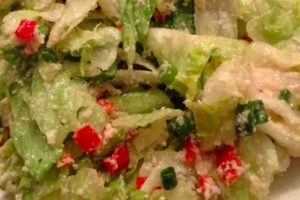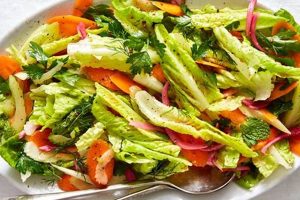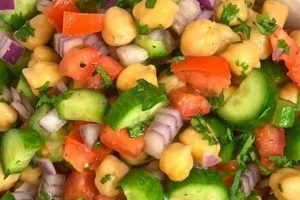A Tuscan bread salad, traditionally made with stale bread, tomatoes, onions, cucumbers, basil, and vinaigrette, offers a resourceful way to utilize leftover ingredients. Variations may incorporate other vegetables like bell peppers or olives, and sometimes proteins such as anchovies or chickpeas. A simple, refreshing dish perfect for summer meals, it showcases the versatility of basic ingredients.
This dish exemplifies mindful consumption by transforming otherwise discarded bread into a delicious and satisfying meal. Its origins lie in peasant cuisine, highlighting the ingenuity born from necessity. The combination of fresh vegetables and soaked bread creates a textural contrast that is both appealing and unique. Its adaptability allows for customization based on seasonal produce and personal preferences, making it a timeless and practical culinary creation.
Exploration of specific ingredient combinations, regional variations, and preparation techniques can further enhance appreciation for this classic dish. Examining these aspects provides a deeper understanding of its enduring appeal and its place within culinary history.
Tips for Crafting the Perfect Panzanella
Achieving optimal flavor and texture requires attention to specific details. The following guidance ensures a successful outcome.
Tip 1: Bread Selection is Key: Day-old, crusty bread is ideal. Avoid overly soft breads. Ciabatta, sourdough, and miche are excellent choices. Proper bread texture is crucial for absorbing the vinaigrette without becoming mushy.
Tip 2: Salting the Tomatoes: Salting and draining chopped tomatoes releases excess moisture, preventing a watery salad. This step concentrates their flavor and improves the overall dish.
Tip 3: Balancing Acidity: A harmonious vinaigrette is essential. Adjust the balance of oil, vinegar, and seasonings to complement the other ingredients. Consider a touch of Dijon mustard or minced garlic for added complexity.
Tip 4: Gradual Ingredient Incorporation: Add the vinaigrette to the bread gradually, allowing it to absorb slowly. This prevents oversaturation. Incorporate the vegetables just before serving to maintain their crispness.
Tip 5: Fresh Herbs Elevate Flavor: Basil is traditional, but other fresh herbs such as oregano or mint can be added for nuanced flavor profiles. Incorporate herbs just before serving to maximize their aroma and taste.
Tip 6: Resting Time Enhances Flavor: Allowing the salad to rest for a short period, after combining the bread and vinaigrette, allows the flavors to meld. This step is crucial for optimal enjoyment.
Tip 7: Customization Encourages Creativity: Don’t be afraid to experiment. Adding other vegetables, such as cucumbers, bell peppers, or red onion, enhances the salad’s complexity. Consider adding proteins such as grilled chicken, chickpeas, or white beans.
Attention to these details ensures a delightful culinary experience. Mastering these techniques elevates a simple combination of ingredients into a memorable dish.
By understanding these fundamental principles, one can fully appreciate the potential of this versatile and flavorful salad.
1. Stale Bread
Stale bread forms the cornerstone of panzanella salad. Its dry texture is essential for absorbing the vinaigrette, creating a chewy, flavorful base. Fresh bread, conversely, would become soggy and disintegrate. The staleness allows the bread to soak up the dressing without losing its structure, contributing a unique textural element. This resourcefulness transforms what might be considered a leftover ingredient into a key component of a delicious dish. Consider, for example, how Tuscan farmers traditionally utilized day-old bread, minimizing waste while maximizing flavor.
The choice of bread influences the final result. A crusty loaf, such as ciabatta or sourdough, holds its shape better than a softer bread. The size and shape of the bread pieces also affect absorption. Cubing the bread provides sufficient surface area for even saturation, while larger pieces offer more textural contrast. The balance between bread and other ingredients is crucial; too much bread can result in a dry salad, while too little may not adequately absorb the dressing. Observing how different bread types absorb the vinaigrette provides practical insight into achieving the desired texture and flavor profile.
The transformation of stale bread into a delectable salad component underscores the ingenuity of panzanella. This resourceful approach minimizes food waste and highlights the importance of texture in culinary creations. Understanding the role of stale bread in panzanella provides a deeper appreciation for its unique characteristics and culinary potential. Further exploration of regional variations can reveal additional insights into the diverse applications of this simple yet crucial ingredient.
2. Ripe Tomatoes
Ripe tomatoes contribute essential flavor and texture to panzanella salad. Their sweetness and juiciness counterbalance the acidity of the vinaigrette and the chewiness of the bread. Underripe tomatoes lack the necessary sweetness, while overripe tomatoes can become mealy and contribute excessive moisture, resulting in a less balanced salad. The selection of appropriate tomatoes directly influences the overall taste and textural harmony. Consider a Tuscan panzanella, where the sweetness of ripe tomatoes complements the savory notes of the other ingredients, creating a harmonious flavor profile. Heirloom varieties, with their diverse flavors and colors, further enhance the complexity.
Tomato preparation methods also impact the final dish. Salting and draining sliced tomatoes prior to adding them to the salad draws out excess moisture, preventing a watery consistency. This step concentrates the tomato flavor, intensifying its contribution to the overall composition. Furthermore, the size and shape of the tomato pieces influence the distribution of flavor and texture throughout the salad. Larger pieces provide bursts of juicy sweetness, while smaller pieces offer a more integrated flavor experience. Different cutting techniques, such as dicing or slicing, offer varied textural experiences within the salad.
The interplay between ripe tomatoes and other ingredients in panzanella highlights the importance of ingredient selection and preparation. Achieving the desired balance requires attention to ripeness, moisture content, and cutting techniques. These considerations ensure the tomatoes contribute optimal flavor and texture, resulting in a cohesive and satisfying culinary experience. Further exploration of tomato varieties and preparation methods offers opportunities to enhance and personalize panzanella recipes.
3. Vinaigrette
Vinaigrette serves as the unifying element in panzanella salad, binding the disparate ingredients and contributing essential acidity. It transforms stale bread into a palatable component by softening its texture and imparting flavor. The balance of oil and vinegar, along with other seasonings, determines the overall character of the salad. Careful consideration of vinaigrette composition is crucial for achieving a harmonious and flavorful result.
- Acidity
The acidity in vinaigrette, primarily derived from vinegar, balances the sweetness of the tomatoes and other vegetables. The choice of vinegar influences the final flavor profile. Red wine vinegar offers a robust tang, while white wine vinegar provides a milder acidity. Balsamic vinegar introduces a subtle sweetness and complexity. Lemon juice can also provide a bright, citrusy alternative. The level of acidity affects the overall taste and can be adjusted to complement the other ingredients. For instance, a more acidic vinaigrette might pair well with sweeter tomatoes, while a milder vinaigrette might be preferred with more savory additions.
- Oil
Oil provides richness and body to the vinaigrette, coating the bread and vegetables. Extra virgin olive oil is a classic choice, offering a fruity flavor that complements the Mediterranean origins of the salad. Other oils, such as avocado or grapeseed oil, can also be used, each imparting its own subtle flavor nuances. The ratio of oil to vinegar affects the texture and mouthfeel of the vinaigrette. A higher oil content creates a richer, more emulsified dressing, while a higher vinegar content results in a thinner, more tart dressing. The quality of the oil significantly influences the overall flavor of the vinaigrette and the salad as a whole. For example, a robust extra virgin olive oil can enhance the flavors of ripe tomatoes and fresh basil.
- Seasoning
Seasoning enhances the complexity of the vinaigrette. Salt and pepper are essential for balancing the flavors. Other seasonings, such as garlic, Dijon mustard, or herbs, can be added to create more nuanced flavor profiles. The choice of seasonings should complement the other ingredients in the salad. Freshly ground black pepper adds a subtle spice, while minced garlic contributes a pungent savory note. The careful balance of seasonings elevates the vinaigrette beyond a simple mixture of oil and vinegar, transforming it into a complex and flavorful element. For example, the addition of red pepper flakes can introduce a touch of heat, while a pinch of sugar can balance excessive acidity.
- Emulsification
Emulsification, the process of combining oil and vinegar into a stable mixture, affects the texture and distribution of the vinaigrette throughout the salad. Whisking or shaking the ingredients vigorously creates a temporary emulsion, allowing the oil and vinegar to coat the bread and vegetables evenly. Adding an emulsifying agent, such as a small amount of Dijon mustard or honey, helps create a more stable emulsion, preventing the oil and vinegar from separating quickly. Proper emulsification ensures a consistent flavor and texture throughout the salad, enhancing the overall dining experience. A well-emulsified vinaigrette clings evenly to the ingredients, preventing pockets of excessive oil or vinegar.
The vinaigrette’s role extends beyond simply dressing the salad; it acts as a flavor catalyst, harmonizing the various components and creating a cohesive culinary experience. Understanding the interplay of acidity, oil, seasoning, and emulsification allows for precise control over the final flavor profile, enabling customization and creativity within the framework of this classic dish. Mastering the art of vinaigrette preparation elevates the panzanella salad from a simple combination of ingredients to a complex and satisfying culinary creation.
4. Fresh Herbs
Fresh herbs contribute a vibrant aromatic dimension to panzanella salad, elevating it beyond a simple bread and tomato dish. Their inclusion introduces a layer of complexity, intertwining with the other ingredients to create a balanced and nuanced flavor profile. The selection and application of herbs significantly influence the final character of the salad. Basil, a traditional choice, offers a sweet, slightly peppery aroma that complements the ripe tomatoes and tangy vinaigrette. Other herbs, such as mint or oregano, can be incorporated to create alternative flavor profiles, reflecting regional variations or personal preferences. For instance, a Tuscan panzanella might feature basil and parsley, while a Sicilian version might incorporate mint and oregano. The quantity of herbs used also affects the overall balance; a light hand preserves the freshness, while an overabundance can overwhelm the other flavors.
The freshness of the herbs is paramount. Dried herbs lack the vibrant aroma and flavor of their fresh counterparts. Incorporating herbs at the right stage of preparation is equally crucial. Adding them too early can diminish their delicate flavors, while adding them just before serving preserves their vibrancy. Chopping or tearing the leaves releases their aromatic oils, intensifying their impact. The interplay between the herbs and the vinaigrette is also significant. The vinaigrette acts as a carrier for the herbal flavors, distributing them throughout the salad. Consider the contrast between whole basil leaves, gently bruised to release their aroma, and finely chopped parsley, distributed throughout the salad for a more integrated herbal presence.
Understanding the role of fresh herbs in panzanella allows for a more nuanced appreciation of this classic dish. Their judicious selection and application contribute not only to flavor but also to aroma and visual appeal, enhancing the overall sensory experience. This seemingly simple addition elevates the salad from a rustic combination of ingredients to a sophisticated culinary creation. The potential for customization, through the exploration of different herb combinations and preparation techniques, allows for endless variations and personalized interpretations of this versatile dish.
5. Optional Additions
Optional additions offer opportunities to personalize and enhance panzanella salad, expanding its flavor profile and textural complexity beyond the traditional core ingredients. These additions, while not essential to the fundamental composition, allow for creative exploration and adaptation based on personal preferences, seasonal availability, and regional culinary traditions. Understanding the potential contributions of various optional ingredients allows for a more nuanced approach to crafting a panzanella salad.
- Vegetables
Incorporating additional vegetables introduces textural and flavor variations. Cucumbers contribute a refreshing coolness and crispness, contrasting with the chewy bread and juicy tomatoes. Bell peppers, available in various colors, add sweetness and a subtle vegetal flavor. Red onion provides a pungent bite, balancing the other flavors. Fennel offers a delicate anise flavor, adding a layer of complexity. The selection of vegetables can reflect seasonal availability, allowing for adaptations throughout the year. A summer panzanella might feature fresh corn kernels, while a fall version might include roasted butternut squash. The quantity and proportion of vegetables should be carefully considered to maintain balance and prevent overwhelming the core ingredients.
- Protein
Adding protein transforms panzanella into a more substantial meal. Grilled chicken or fish provides a lean protein source, complementing the fresh vegetables. Chickpeas or cannellini beans offer a vegetarian option, contributing a creamy texture and earthy flavor. Anchovies, a traditional Tuscan addition, provide a salty, umami richness. The choice of protein should complement the other flavors and textures within the salad. Flaked tuna or salmon can be incorporated, offering a lighter protein option. The inclusion of protein expands the versatility of panzanella, adapting it from a side dish to a main course.
- Cheese
Cheese introduces a creamy, savory element to panzanella. Crumbled feta cheese, with its salty tang, complements the other Mediterranean flavors. Fresh mozzarella offers a mild, milky flavor and soft texture. Parmesan cheese, shaved or grated, contributes a sharp, nutty taste. The choice of cheese should consider the existing flavors and textures. Ricotta salata, a firm, salty sheep’s milk cheese, can also be incorporated. The amount of cheese added should be judicious to prevent overpowering the other ingredients. Cheese enhances the richness and complexity of the salad, creating a more satisfying culinary experience.
- Other additions
A variety of other ingredients can further enhance the flavor and texture of panzanella. Capers, with their briny, salty flavor, add a pungent note. Olives, both green and black, contribute a salty, fruity element. Toasted pine nuts or walnuts provide a crunchy textural contrast and nutty flavor. A drizzle of balsamic glaze adds a touch of sweetness and visual appeal. These additions, while not traditional, offer opportunities for personalized variations. Sun-dried tomatoes intensify the tomato flavor, while artichoke hearts contribute a subtle earthiness. Experimentation with different additions allows for creative exploration and the development of unique flavor profiles.
The thoughtful incorporation of optional additions elevates panzanella salad from a simple combination of ingredients to a customizable culinary canvas. These additions allow for creative expression and the development of unique flavor profiles, adapting the classic dish to individual preferences and seasonal ingredients. By understanding the potential contributions of various optional components, one can fully explore the versatility and complexity of panzanella salad.
Frequently Asked Questions
Addressing common inquiries regarding panzanella salad provides clarity and facilitates successful preparation.
Question 1: Can fresh bread be used?
While fresh bread is not ideal, it can be utilized with adjustments. Toasting or grilling fresh bread removes excess moisture, creating a texture more suitable for absorbing the vinaigrette. This step prevents the salad from becoming overly soggy.
Question 2: What type of vinegar is best?
Red wine vinegar is traditional, but white wine vinegar, balsamic vinegar, or even lemon juice offer suitable alternatives. Selection depends on desired flavor profiles and the balance of other ingredients. Experimentation is encouraged to determine personal preference.
Question 3: How long should the salad rest?
A resting period of 15-30 minutes allows the bread to absorb the vinaigrette and the flavors to meld. However, avoid excessive resting, which can lead to an overly soggy texture. The optimal resting time depends on the bread type and the amount of vinaigrette used.
Question 4: Can panzanella be made ahead of time?
While some components can be prepared in advance, assembling the salad just before serving is recommended. This preserves the crispness of the vegetables and prevents the bread from becoming excessively saturated. Advanced preparation of the vinaigrette and chopping of vegetables streamlines the final assembly process.
Question 5: How should leftover panzanella be stored?
Refrigeration in an airtight container is recommended. However, the texture of the bread may soften upon storage. Consume leftovers within one to two days for optimal quality.
Question 6: Must tomatoes be used?
While tomatoes are traditional, other vegetables can be substituted or added. Consider cucumbers, bell peppers, or red onion for textural and flavor variations. Adapting the vegetable components allows for seasonal variations and personalized preferences.
Understanding these key aspects of panzanella preparation ensures a successful outcome. Addressing these frequently asked questions clarifies potential challenges and facilitates informed decision-making throughout the process.
Further exploration of specific recipe variations and techniques provides opportunities for customization and culinary exploration.
Recipe Panzanella Salad
Examination of recipe panzanella salad reveals a dish steeped in resourcefulness and culinary tradition. From the utilization of stale bread to the balanced interplay of fresh vegetables, herbs, and vinaigrette, each component contributes to the creation of a harmonious and flavorful whole. The adaptability of this classic salad allows for both adherence to tradition and creative exploration through the incorporation of various regional ingredients and personalized adaptations. An understanding of the underlying principlesbread selection, vinaigrette composition, and ingredient balanceempowers culinary enthusiasts to achieve optimal results.
Panzanella salad embodies a timeless approach to mindful cooking, transforming simple ingredients into a satisfying and flavorful meal. Continued exploration of regional variations and creative adaptations promises to further enrich the culinary landscape and ensure the enduring appeal of this versatile dish.






